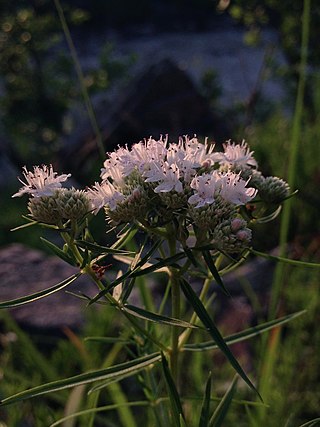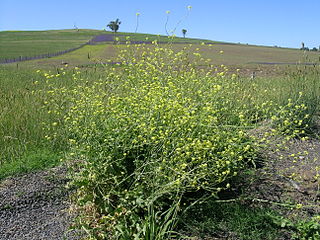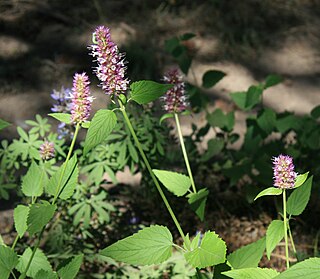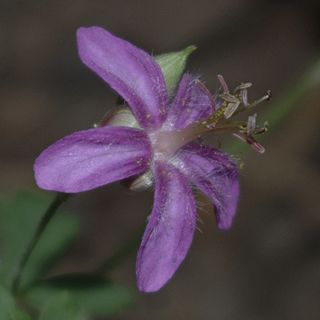
Oregano is a species of flowering plant in the mint family Lamiaceae. It was native to the Mediterranean region, but widely naturalised elsewhere in the temperate Northern Hemisphere.

Purple sage has various meanings, mostly referring to plants or to Zane Grey's novel Riders of the Purple Sage, set in Utah. There is disagreement about which plant Grey had in mind.

Monardella is a genus of approximately 40 species of annual and perennial plants native to western North America from British Columbia to northwestern Mexico. They are grown for their highly aromatic foliage, which in some species is used for herbal teas. The two-lipped, tubular flowers are formed in terminal clusters and are most usually red, pink, or purple.

Cunila origanoides, with the common names stone mint, frost mint, dittany, and American dittany, is a perennial late-summer-flowering subshrub with small purple flowers that is native to the central and eastern United States. It belongs to the Lamiaceae (mint) family and is the only species in the Cunila genus native to the United States. It grows in habitats such as dry forests and the thin soil around rock outcrops. This species has historically been cultivated for use as a medicinal herb, tea, and ornamental plant.

Echinacea purpurea, the eastern purple coneflower, purple coneflower, hedgehog coneflower, or Echinacea, is a North American species of flowering plant in the family Asteraceae. It is native to parts of eastern North America and present to some extent in the wild in much of the eastern, southeastern and midwestern United States, as well as in the Canadian Province of Ontario. It is most common in the Ozarks, the Mississippi Valley, and the Ohio Valley. Its habitats include dry open woods, prairies, and barrens.

Monarda fistulosa, the wild bergamot or bee balm, is a wildflower in the mint family Lamiaceae, widespread and abundant as a native plant in much of North America. This plant, with showy summer-blooming pink to lavender flowers, is often used as a honey plant, medicinal plant, and garden ornamental. The species is quite variable, and several subspecies or varieties have been recognized within it. Despite its name, it has no relation to the 'true' bergamot, a citrus fruit.

Echinacea simulata, commonly called wavy leaf purple coneflower, glade coneflower, or prairie purple coneflower, is a species of perennial flowering plant in the family Asteraceae. It is native to the east-central states of the United States. Its natural habitat is dry, calcareous, open areas such as barrens and woodlands.

Pycnanthemum tenuifolium, the narrowleaf mountainmint, slender mountainmint, common horsemint or Virginia thyme, is a perennial herbaceous plant in the mint family, Lamiaceae. It is native to central and eastern North America.

Hirschfeldia incana is a species of flowering plant in the mustard family known by many common names, including shortpod mustard, buchanweed, hoary mustard and Mediterranean mustard. It is the only species in the monotypic genus Hirschfeldia, which is closely related to Brassica. The species is native to the Mediterranean Basin but it can be found in many parts of the world as an introduced species and often a very abundant noxious weed. This mustard is very similar in appearance to black mustard, but is generally shorter. It forms a wide basal rosette of lobed leaves which lie flat on the ground, and it keeps its leaves while flowering. Its stem and foliage have soft white hairs. Unlike black mustard, H. incana is a perennial plant.

Agastache urticifolia is a species of flowering plant in the mint family known by the common name nettleleaf giant hyssop or horse mint.

Symphyotrichum sericeum is a species of flowering plant in the family Asteraceae native to central North America. Commonly known as western silver aster, western silvery aster, and silky aster, it is a perennial, herbaceous plant that may reach 70 centimeters tall. Its flowers have purple ray florets and pink then purple disk florets, and its leaves are firm and silvery-green.

Astragalus austiniae is a species of milkvetch known by the common name Austin's milkvetch. It is native to the Sierra Nevada of California and Nevada in the vicinity of Lake Tahoe. It is a plant of the alpine climate of the high mountains, where it tolerates exposed areas.

Scutellaria incana, the hoary skullcap or downy skullcap, is a species of perennial flowering plant in the mint family Lamiaceae. It is native to North America and is primarily found in the eastern United States as well as some parts of the Midwest.

Pleroma heteromallum, synonyms including Tibouchina grandifolia and Tibouchina heteromalla, known by the common name silverleafed princess flower in English, is a species of evergreen flowering plant in the family Melastomataceae. It is native to French Guiana, Bolivia and Brazil.

Geranium caespitosum, the purple cluster geranium or pineywoods geranium, is a perennial herb native to the western United States and northern Mexico. Its US distribution includes Arizona, Colorado, Nevada, New Mexico, Texas, Utah, and Wyoming.
Trichostema oblongum, known by the common names oblong bluecurls and mountain bluecurls, is a species of flowering plant in the mint family.

Tecophilaea cyanocrocus, the Chilean blue crocus, is a flowering perennial plant that is native to Chile, growing at 2,000 to 3,000 m elevation on dry, stony slopes in the Andes mountains. Although it had survived in cultivation due to its use as a greenhouse and landscape plant, it was believed to be extinct in the wild due to overcollecting, overgrazing, and general destruction of habitat, until it was rediscovered in 2001.

Allium bisceptrum, also known as the twincrest onion or aspen onion, is a high elevation plant native to western United States. It is a perennial that thrives under damp and shady conditions or open meadows in California, Arizona, New Mexico, Nevada, Oregon, Washington, Idaho, and Utah.

Blephilia hirsuta, commonly known as hairy wood-mint or hairy pagoda plant, is a species of herbaceous perennial in the mint family Lamiaceae. It is native to eastern North America.

Poliomintha is a genus of flowering plants in the mint family, Lamiaceae. It is native to the southwestern United States, Haiti, and northern Mexico.


















